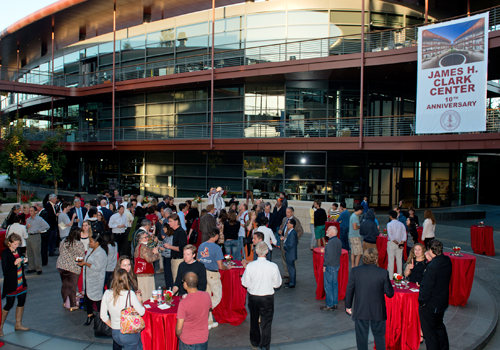
Stanford Report, October 13, 2013
Entrepreneur Jim Clark, founder of Silicon Graphics and Netscape, will give an additional $60 million to Stanford University. He made the announcement during the Oct. 9 celebration of the 10th anniversary of the James H. Clark Center, the home of Bio-X, made possible by Clark's first major gift to Stanford.
Tech leader Jim Clark cites university's academic environment as crucial to producing insights at the intersection of life sciences, technology and engineering.
As the last speaker at an afternoon symposium celebrating the landmark achievements of the Clark Center and Bio-X, Clark told the audience that he would like to contribute $60 million more toward interdisciplinary research at the intersection of life sciences, technology and engineering.
"The research and technology that have been produced in the Clark Center over the past 10 years have exceeded my wildest expectations and, it is clear, will continue to make a big impact on human health going forward," Clark said. "My gift to Stanford is one of the best things I have ever done."
The James H. Clark Center for Biomedical Engineering and Sciences was made possible after Clark made a lead gift of $90 million in 1999 to jump-start a cross-disciplinary initiative in biomedical engineering and sciences, known today as Bio-X. The 146,000-square-foot building, which has been emulated by universities worldwide since it opened in 2003, co-locates more than 800 scientists in disciplines including biology, medicine, chemistry, physics and engineering.
On the morning of Clark's announcement , the Nobel Prize in chemistry was awarded to a Bio-X faculty member: Michael Levitt, professor in structural biology. The award recognized Levitt's own cross-disciplinary work modeling the chemical processes of molecules, using his expertise in computer science, biology and quantum physics.

The Clark Center 10-Year Anniversary celebration.
"Wednesday was a very joyous day at Stanford, one to celebrate and reflect upon the significant achievements that can result from interdisciplinary research," Stanford President John Hennessy said. "Jim Clark is a superb engineer and a visionary entrepreneur who launched a series of companies that changed the way we live and work. We couldn't be more thrilled that he would like to acknowledge the success of Bio-X with an even greater investment in its future."
Clark was a Stanford professor in the early 1980s, when he was encouraged to develop computer chip technologies that became the basis for his first private venture, Silicon Graphics. He went on to found Netscape, Healtheon and MyCFO.
In numerous speaking engagements on campus, Clark often credits Stanford's encouragement for crossing traditional academic barriers for his success and for the shift in his academic career from engineering to physics to computer science. "My most interesting and profound insights have come when I changed fields and was able to look at things in new ways. Stanford's academic environment encourages this way of tackling problems and I look forward to the great innovations that it will produce," Clark said.
